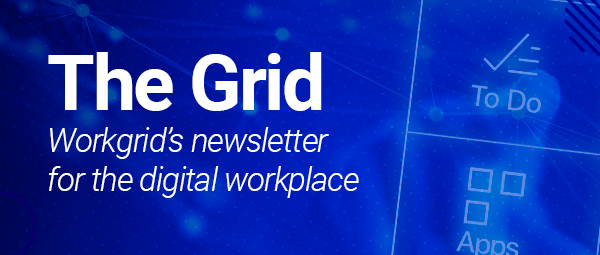The Evolution of Governed AI in the Workplace
Governance is essential at every step of AI's evolution within an organization. As Artificial Intelligence (AI) shifts from a futuristic buzzword to a driving force behind modern business strategy, its ability to streamline operations, enhance decision-making, and transform employee experiences becomes clear. However, AI’s full potential can only be realized through a structured journey where governance provides the foundation for trust, security, and accountability at every stage of AI maturity.
At Workgrid, our AI Maturity Model charts the path for AI adoption and considers governance a crucial component throughout each phase. From the initial Assess stage, where organizations evaluate their AI readiness, to the Transformative stage, where AI drives strategic innovation, governance ensures that AI evolves responsibly, securely, and in alignment with business objectives.
While many AI maturity models exist in the market from renowned analysts like Forrester, Gartner, and others, each offers a unique perspective on how organizations should adopt AI. These models provide valuable frameworks, but choosing one that aligns with your business needs and AI goals is essential. At Workgrid, our AI Maturity Model offers a simple framework into understanding that digital workplace leaders can improve the employee experience with the use of an AI Assistant regardless of where they are in their journey.
Let’s explore the AI maturity stages and the considerations for each.
![[asset] AI Maturity Stages](https://images.ctfassets.net/z7p73u8c0thn/hVO07ResCX2xCIrzaCHiB/92b8b09680c602d152465f264b90ae5a/AI-Maturity-Stages.png?w=1200&h=675&q=60&fm=png&bg=transparent)
Stage 1: Assess (Foundational Awareness)
At the Assess stage, organizations are in the early phases of their AI journey. They have a basic understanding of AI but have not yet begun actively deploying it. This stage focuses on research, exploration, and evaluation of AI’s potential for business.
An Assistant with Broader Potential
Even in this early stage, an AI Assistant can integrate seamlessly into the workplace. For example, leveraging integrations with backend systems through APIs, triggers, and deep integrations. Without diving into complex AI applications, an Assistant brings value to organizations in the Assess stage by delivering personalized news, notifications, and alerts—keeping employees informed and connected without constantly app-hopping between systems. This boosts productivity by providing real-time updates and creates a bridge between business systems and employees, improving the overall experience.
Introducing this early-stage assistant allows organizations to engage employees while assessing AI's broader potential. It’s a low-risk way to trial AI capabilities and a solid step in building a framework for the next phase of pilots.
![[asset] Cornerstone-Training-Reminders](https://images.ctfassets.net/z7p73u8c0thn/3cZ8MxaA7zADo3i1crOCR/c19ec6350d47517def33f15924a5dd6c/LMS-Cornerstone.png?w=735&h=650&q=60&fm=png&bg=transparent)
Foundational AI Challenges
Data readiness: Organizations at the Assess stage often struggle with data availability, quality, and integration, as they may not have the necessary infrastructure for AI implementation.
Talent gaps: A shortage of internal AI expertise can limit progress. Many companies must hire or partner with experts to guide them in developing an AI strategy. Internal talent requirements and resources inside the organization are unknown.
Risks: Many risks have yet to be evaluated, making the assess stage the riskiest. Shadow AI will occur, businesses will request access to leverage commonplace GenAI solutions for business, and IT will need answers.
Foundational AI Considerations
Begin assessing current data infrastructure and building a roadmap for AI. Vital considerations should include quick-start GenAI use cases that offer minimal risk, where AI will bring the most value, and how to align AI projects with broader business goals.
Stage 2: Active (Experimentation and Early Adoption)
Once an organization moves into the Active stage, it begins experimenting with AI ‘pilots’ on a small scale. Typically, this involves persona-driven proof-of-concept projects demonstrating AI’s potential impact across various departments. Ideally, there is an emphasis on business value and the ROI of the proposed solutions.
Early Adoption of AI at Work
One standout solution in this stage is AI Assistant generative AI apps – often referred to as Genie Apps — which include a suite of customizable applications that tailor AI deployments to specific models, personas, and business needs. Whether generating blog content or summarizing complex documents, Genies give businesses precise control over AI use cases. By setting clear guardrails, companies can ensure GenAI usage aligns with business goals while reducing shadow AI risks.
Tasks and Actions
In the Active stage, AI Assistant use cases go beyond content generation to help drive efficiency in HR and IT. Automating repetitive tasks like HR requests and IT service tickets lightens administrative loads and frees employees to focus on strategic, high-value activities.
![[asset] Editor Genie Switchback](https://images.ctfassets.net/z7p73u8c0thn/6oGUs93NBm1Dna61zExElX/c221a509d76286fa597adaee647aa922/Editor_Genie_Switchback.png?w=1200&h=1200&q=60&fm=png&bg=transparent)
Experimental AI Challenges
Lack of scalability: Initial AI implementations may be successful on a small scale, but organizations may struggle to scale these efforts across the entire business if they do not provide a proper evaluation of the projects. Organizational change management (OCM) techniques should be used for communication and a governance framework should be introduced.
Pro-Tip: Look for an AI Assistant that meets your needs where you are and can scale with you. Workgrid’s AI Assistant offers unmatched value at a fraction of the cost compared to competitors. Priced as low as $5/user per month compared to Microsoft Copilot’s $30, organizations can pilot AI without breaking the bank. This cost efficiency allows businesses to explore AI-driven content generation, task automation, and operational enhancements while keeping budgets in check.
Resistance to change: Employees may resist AI adoption, fearing job displacement or changes in workflow. This should be expected and a part of the Organizational Change Management conversations.
Experimental AI Considerations
Engage stakeholders from across the organization early to build trust and demonstrate AI’s benefits. The pilot programs should have a program leader focused on delivering the AI pilots to a body that acts as the steering committee for future investments. Projects without guardrails will fail. Create clear AI use cases and pilot projects, focusing on scalability.
Stage 3: Operational (AI Integrated into Daily Operations)
Organizations at the Operational stage have successfully integrated AI into daily functions, with AI supporting critical business operations. AI delivers measurable results during the operational stage, particularly regarding the employee experience. There are many success stories of driving efficiency and improving workflows in this stage. Moreover, at this stage, the governance framework is quite robust and able to handle the requirements across the business. Leveraging internal resources, mitigating risks, and considering legal regulatory requirements becomes part of the AI execution program.
At this stage, low-code development shines. These types of builder tools enable business technologists to quickly deploy new integrations, apps, and experiences by tapping into hundreds of data sources, LLMs, and pre-built templates. Whether you’re building custom apps, launching payroll tools, or integrating with platforms like ServiceNow, the goal is to empower non-technical users to innovate—without bogging down IT. This accelerates AI solutions across various areas, ensuring AI enhances employee experience.
AI Answers, Actions, and Insights
An AI Assistant powers process automation, handling time-consuming tasks like HR requests, task management, and incident resolution. With the assistance of AI, these processes are handled quickly and accurately, significantly boosting productivity.
Chat to LLMs
At this stage, a direct LLM integration lets employees query large language models in real-time, accessing knowledge to support better decision-making. Whether retrieving complex information or generating insights, an AI Assistant enhances productivity by delivering instant answers.
Agentic AI Capabilities
An AI Assistant doesn’t just follow orders—it anticipates needs. With Agentic AI, an Assistant can make proactive recommendations, becoming an intelligent copilot that drives even greater efficiency in daily operations.
![[asset] office-agent-hero](https://images.ctfassets.net/z7p73u8c0thn/2yakfOmnpfSRkOG9SZ3hXz/a38629ec505c444fe1dc10afe0857f6d/office-agent-hero.png?w=956&h=700&q=60&fm=png&bg=transparent)
Operational AI Challenges
Integration with legacy systems: AI must seamlessly integrate with existing IT infrastructures and source systems. This may require significant investments in focusing on data analysis and data integrity.
Pro Tip: Look for an AI solution that offers pre-built and tested integration solutions for your most popular business systems. Here’s a look at Workgrid’s template catalog.
Managing AI performance: As AI becomes part of daily operations, organizations must continuously monitor and refine proprietary and custom AI design to ensure they deliver accurate and actionable insights. This is why solution providers like Workgrid aid in providing solutions that enable AI practitioners the ability to meet the needs of employees out of the box.
Operational AI Considerations
Develop a robust data governance framework to ensure data quality, security, and privacy as AI systems scale. Prioritize ongoing training to help employees work alongside AI effectively. AI dexterity and resource planning are critical at this stage; as AI becomes embedded alongside employees the proper skill set and role charters will require redefinition.
Stage 4: Transformative (AI-Driven Innovation and Strategy)
AI becomes part of the organization’s core strategy at the Transformative stage, driving innovation, competitive advantage, and operational excellence. AI is deeply embedded across business units, within the customer experience (CX), and influences decision-making via work transformation. With an AI Assistant, organizations can seamlessly integrate systems, surface key insights, and deliver critical alerts directly to employees.
Strategic Decision Making
On the workforce side, predictive analytics enable organizations to anticipate talent needs and optimize workforce planning. By delivering these insights where they’re needed, an AI Assistant helps ensure seamless decision-making. With its ability to reach across connected systems, an Assistant brings siloed AI applications into the flow of work, turning isolated data into actionable insights. By acting as a gateway to all your data, an AI Assistant for work doesn’t just automate tasks—it streamlines the flow of information, keeping your organization informed and proactive.
![[Asset] ServiceNow-Catalog-Hero](https://images.ctfassets.net/z7p73u8c0thn/4YpDiPANyGwiX7CajZYabl/8a585028ded47bfe487bf5800dd89085/ServiceNowCatalogHero.png?w=956&h=700&q=60&fm=png&bg=transparent)
Transformative AI Challenges
AI ethics and governance: At this stage, organizations must address ethical concerns around AI, such as bias in AI algorithms and the transparency of AI-driven decisions. Navigating regulatory requirements becomes increasingly complex.
Sustaining AI momentum: Once AI is fully integrated, businesses face the challenge of sustaining innovation. AI requires constant refinement and adaptation to remain relevant and valuable; particularly for organizations which leverage AI for backbone business operations and CX initiatives.
Transformative AI Considerations
Evolve the AI governance and ethics policies to manage risks and ensure compliance. Fostering a culture of continuous innovation where AI becomes a catalyst for ongoing transformation and competitive advantage becomes paramount.
Overcoming Enterprise AI Challenges at Every Stage
Across all stages of the AI maturity model, organizations must navigate several key challenges:
Data management: High-quality, accessible data is the foundation for effective AI deployment. Establishing a data strategy emphasizing integration, governance, and privacy is critical at every stage.
Talent acquisition and training: Investing in AI expertise— hiring new talent, upskilling current employees, or partnering with AI experts—helps ensure successful AI adoption.
Change management: Building a culture that embraces AI requires clear communication, strong leadership, and demonstrated value from AI initiatives. Engaging employees and addressing their concerns helps foster buy-in.
Solutions for Scalability: AI systems need to be built for scale; sized to stage. During the Assess and Active stage, best-of-breed vendors offer tremendous value to begin layering AI use cases within the business that are low risk. As the organization matures in its AI journey, more home-grown strategic investments can be developed. Ideally, these are attuned to the culture, infrastructure, and resources aligned to the program strategy that expand AI’s impact across the organization.
Charting a Path to AI Transformation
AI is not a one-size-fits-all solution, and each organization’s journey is unique. By understanding where they stand on the AI maturity model - whether in the Assess, Active, Operational, or Transformative stage - organizations can strategically plan their AI implementations, navigate challenges, and unlock the full potential of AI to drive meaningful business outcomes.
At Workgrid, we’re committed to helping organizations move through each stage of AI maturity. Our Workgrid AI Assistant is designed to meet organizations wherever they are on their journey, providing scalable, intelligent solutions that enhance employee experiences and drive operational efficiency.




